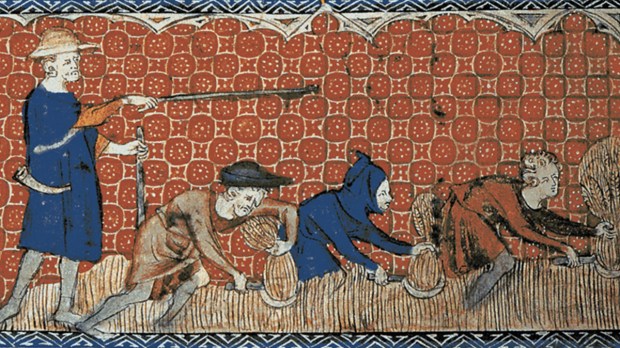Lenten Campaign 2025
This content is free of charge, as are all our articles.
Support us with a donation that is tax-deductible and enable us to continue to reach millions of readers.
In early November, news broke that a miniature 15th-century “Bible” had been discovered near York. The one-and-a-half centimeter, five-gram gold bead is cast in the form of an open book, and the interior is adorned with engravings featuring two medieval saints.
Sometimes you can judge a “Bible” by looking at its cover. Especially when its cover does not include any biblical characters but features St. Leonard of Noblac (a Frankish saint of the 5th century) and St. Margaret of Antioch (one of the most revered saints of the Middle Ages) instead.
In short, this “Bible” is not a Bible, as both the Daily Mail and the BBC claimed. As Kathleen Kennedy rightly pointed out in her article in Hyperallergic, this is a prayer book instead. Most likely, a Book of Hours.
The fact that there are religious engravings in the bead does not imply, at all, that it is supposed to represent a Bible. These engravings belong to a wider iconographic tradition that can be easily traced back to what the noted German art historian Erwin Panofsky referred to different “renascences” in Western Art —a series of distinctive moments of radical artistic and technological innovation during the Middle Ages that not only made the Renaissance possible, but that debunk the myth of the “dark” ages. In fact, Panofksy’s whole argument leans on a healthy skepticism regarding these historical periodizations: what kind of “event” can actually be said to separate one epoch from the other? When does the Renaissance really begin? In short, he understands that there might not necessarily be a dividing line separating “medieval” and “renaissance” culture. This bead might be, to a certain extent, yet another proof of it.
Part of Panofsky’s argument has to do with the fact that several different renaissances can be identified all throughout medieval history, the first one of them being the Carolingian renovatio. Panofsky writes:
“During and after the disruption of the Western Roman Empire, the interrelated and overlapping processes of barbarization, Orientalization, and Christianization had led to an almost total eclipse of classical culture in general and classical art in particular. Oases had been left in regions such as Italy, North Africa, Spain, and South Gaul, where we can observe the survival of what has nicely been termed ‘sub-antique’ style; and in at least two centers we even find what amounts to revivals as opposed to survival. Determined efforts to assimilate Latin models were made in England, which produced, for example, the Codex Amiatinus and, in sculpture, the Crosses of Ruthwell or Bewcastle, and where the classical tradition was always a force both more persistent and more self-conscious (either in the sense of purism or in the sense of romanticism) than was the case on the Continent.”
Erwin Panofsky, Renaissance and renascences in Western Art.
Panofsky identifies at least four more of these renaissances, besides the Carolingian renovatio. One of them is distinctively Anglo-Saxon, its paradigmatic artistic manifestation being the noted Irish Book of Kells, the finest existing medieval illuminated manuscript, long revered for its miniatures and full-page illuminations.
Whereas the Book of Kells is indeed a “Bible” (it is, after all, a compendium of all four canonical Gospels), its groundbreaking aesthetic achievements were widely applied to other objects of daily use —prayer books included, naturally.
As Kennedy notes, the bead offers a perfect example of a favorite style of jewelry in late medieval England: iconographic engraving: “Iconographic rings, rings engraved with images of saints, were the costume jewelry of their day. These rings were made of bronze, silver, or gold, and engraved with popular saints. You might wear your favorite sports team’s jersey, and medieval people wore their favorite saints […] There are many dozens, possibly hundreds, of iconographic rings remaining from 15th-century England in museum and private collections today.”
Again, Leonard and Margaret are not biblical characters. But they are indeed prominently featured in numerous different prayer books. In fact, books of hours were the most popular books of the Middle Ages, made up of shorter versions of the daily prayers sung by friars and monks in convents and monasteries alike. Like the Book of Kells, these books of hours were often generously illustrated, and could even include some prayers to saints. Naturally, if you were to have your own prayer book, you would ask the copyist to include prayers to your own patron saints (or saints for a particular need) in it.
Known in her legend for bursting out of a dragon’s stomach, cross in hand, Margaret of Antioch became a patron saint of childbirth. Leonard was also a saint associated with pregnancy and childbirth, as it is said that through his prayers the queen of the Franks safely bore a male child. Kennedy concludes that “it seems likely that, however it was worn or carried, the bead offers an example, like birth girdles, of the common practice of praying to specific saints for intercession to survive pregnancy and delivery.”

